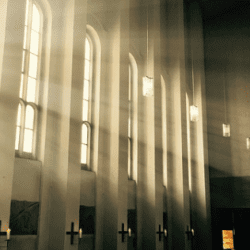By Jeremy Hoover
Terri-Lynn was frustrated one day. She asked, “Why can’t we get more people to come to the church?”
I looked around at our event and felt pretty good about it. We had around twenty people at a children’s event. I considered it an outreach event for Love First, our fledgling church plant in Sarnia, Ontario, yet Terri-Lynn, our longest-standing member, considered it a “church” event.
As I thought about this, I realized that I was discouraged because our attendance was down from when we had tried to organize a Sunday worship service in the field on Kathleen Avenue (an impoverished neighbourhood we have tried to engage with). Here I was, trying to build up numbers through outreach so we could “re-launch” something that would resemble “church,” but Terri-Lynn already considered us to be the church.
I began to ask, “When does a group of believers become a ‘church’?”
I’ve been pondering this question quite a bit lately. The answer might be obvious to you. It used to feel obvious to me. And, objectively, I guess the answer is obvious: a group of believers gathering together is, in fact, a church.
However, when I’m brutally honest with myself, I recognize that the slower pace of outreach in secular culture, along with the small number of folks who gather with Love First, is discouraging. I’ve also had to battle the perception from others that what we’re doing with Love First isn’t a “real” church because we don’t have a place to meet, don’t have an every-week Sunday gathering, and don’t have “enough” people.
Much of church planting theory still revolves around the Christendom model of gathering people for the purpose of a Sunday gathering. Whatever happens in addition to that is extra. But mission, in that paradigm, is subjugated beneath the Sunday service. The Sunday service is what counts, along with its ABCs–attendance, buildings, and cash.
This isn’t to say that the Christendom model undervalues (or de-values) mission. Mission is still important. But mission serves the service, so to speak. The end result of mission is people being transformed into the image of Jesus, but Christendom models express this in terms of the above ABCs.
My experience in secular culture has shown me the truth of Charles Taylor’s words (in A Secular Age) that belief is one option among many, and all beliefs are contestable. Canadian culture has long since moved past, and even dismissed, Christendom as a model. Many evangelical churches are seeing decline and are struggling to understand why, when the reality is that many Canadians just don’t care about the Christian faith.
I don’t mean that they are opposed to or hostile towards Christian faith. Rather, they are “apatheistic.” That is, they have apathy towards the entire concept of God (or gods). They have left it behind and have moved on.
I see this way of thinking and being in my neighbourhood and city. We moved here with high hopes of making bold change in an impoverished community by bringing many people to Christ. What we found was a lot of apathy toward betterment and apatheism toward faith. We felt like we hit a roadblock early, and then further challenges came when late fall/winter hit and folks generally stayed indoors, and then, of course, with the entire Covid-19 scenario.
What, then, is a missionary to do?
I was thankful when I ran across a book late last year. The book was written by Stefan Paas, a missiologist in Denmark as well as a church planter. The book, Pilgrims & Priests, advocates for a theology of church planting in secular culture where the church sees itself as a community of pilgrims (travelers banded together in an unfamiliar land) and priests (our purpose is to be God’s blessing to the world around us). Paas noted that, in secularism, where choices abound and following the Christian faith is simply one choice among many, the church will always be small. The church will always be a small band of believers who see themselves as priests, offering God’s blessings to the community around them.
I found this description very helpful. It helped me refocus away from discouragement that was rooted in the Christendom model of church and helped me focus on the church that we actually had. Terri-Lynn had not read Paas’ book, but she reflected his message: the church is the gathered people of God who offer priestly blessings to those around them. I had been focusing on Christendom metrics while Terri-Lynn was focusing on kingdom metrics.
I’m thankful for people like Terri-Lynn. The life of a church planter can be filled with discouragement and disappointment. People of hope help to push me forward when I’m weary, and our small band of pilgrims and priests will continue to be a blessing in our neighbourhood and city. Our church is growing, not necessarily as we add more people to it, but as we bless our neighbourhood and see the kingdom of God experienced within.














